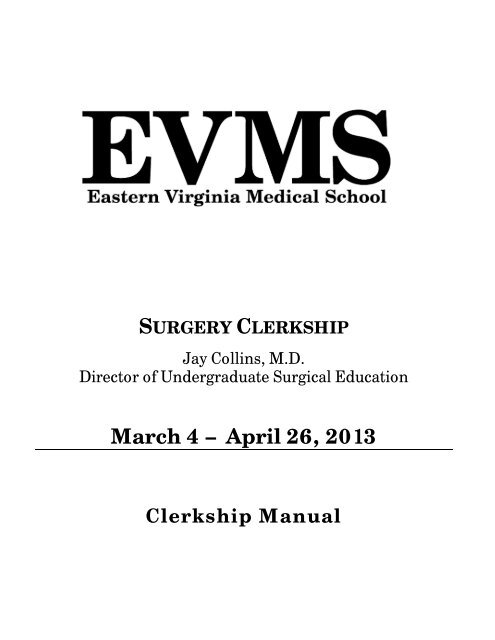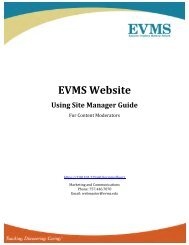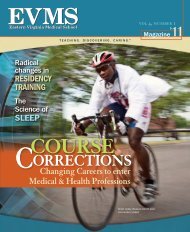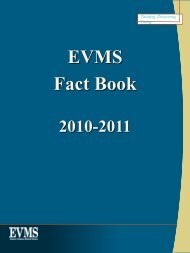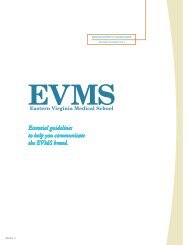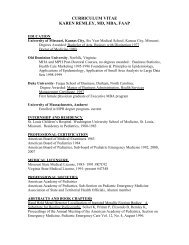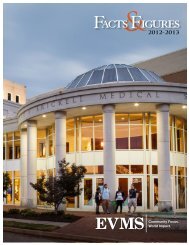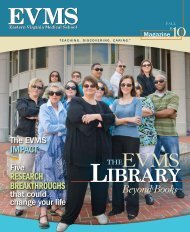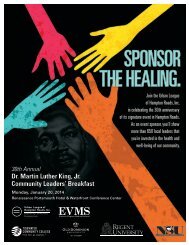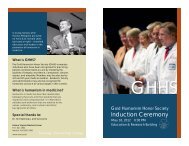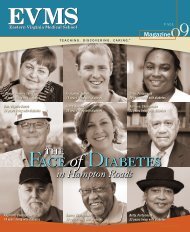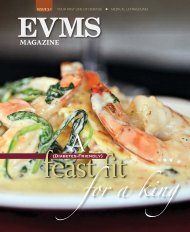surgery clerkship - Eastern Virginia Medical School
surgery clerkship - Eastern Virginia Medical School
surgery clerkship - Eastern Virginia Medical School
Create successful ePaper yourself
Turn your PDF publications into a flip-book with our unique Google optimized e-Paper software.
SURGERY CLERKSHIPJay Collins, M.D.Director of Undergraduate Surgical EducationMarch 4 – April 26, 2013Clerkship Manual
SECTION 2: GENERAL INFORMATION2.1 GENERAL SITE INFORMATIONSITE LOCATION AND CONTACT INFORMATIONSentara Princess Anne Hospital2025 Glenn Mitchell Drive, <strong>Virginia</strong>Beach, <strong>Virginia</strong> 23456(757) 507-0000Site Coordinator: Kirk Heath, M.D.Office Manager: Amy SaundersO: (757) 481-4424Sentara Leigh Hospital830 Kempsville RoadNorfolk, VA(757) 261-6000Site Coordinator: James Snyder, M.D.Assistant: Nancy EleftheratosO: (757) 261-5037Norfolk Surgical Group880 Kempsville Road, Suite 1000Norfolk, <strong>Virginia</strong> 23502Naval <strong>Medical</strong> Center620 John Paul Jones CircleCharette Health Care CenterPortsmouth, VA 23708-2197Site Coordinator: Jared Antevil, MD,CDR, MC, USNAdmin. Assistant: Dovie LoudO: (757) 953-2518F: (757) 953-0836Sentara Norfolk General600 Gresham DriveNorfolk, VA(757) 668-3000EVMS Department of Surgery825 Fairfax Ave., Ste 610Norfolk, VA 23507Site Coordinator: Jay Collins, M.D.Admin. Assistant: Kerry SissonO: (757) 446-89655
2.2 GENERAL RESPONSIBILITIES OF SURGERY CLERKSHIP STUDENTCommunications/ Student E-mail AccountsAll formal communications between this department and its Clerkship students willbe through each student’s assigned EVMS e-mail address. It is the responsibility ofeach student to remain up to date with his or her e-mail account, and ensure his orher respective mailbox is not full. E-mail communications will include importantinformation such as last minute changes to didactic schedules and the administrationof the SHELF examination, changes will also be placed in the Announcementsections in New Innovations.Grand Rounds AttendanceStudents must sign the attendance book for Surgery Grand Rounds (Fridays andoccasional Saturdays, 8:00 am). Attendance at Grand Rounds is required on the dayof your final exam.Clerkship Didactics AttendanceStudents are required to attend every didactic scheduled for their assigned site, withthe limited exception of attendance at home site Small Groups during the week thestudent is assigned to the subspecialty rotations of Vascular or Pediatric Surgery.Clerkship Lectures are mandatory for all students despite their subspecialty siteassignment.Unexcused AbsencesDuring the <strong>surgery</strong> rotation, students are expected to be active members of themedical teams caring for patients in our hospitals, offices, and clinics. In addition,students are expected to assume personal responsibility for their education andtraining, and therefore are expected to be present for all scheduled clinical activities,teaching conferences, lectures, examinations, etc. In the event of an emergency thatrequires absence from the clinical site, students should notify Dr. Collins atcollinjn@evms.edu in the Department of Surgery immediately. Students with 1-2unexcused absences during the <strong>clerkship</strong> will only be eligible to receive a gradeof Pass. Three or more unexcused absences will result in failure of the <strong>clerkship</strong>.Delayed FacultyStudents may not leave the location of an assigned didactic until released by theFaculty member responsible for the presentation, or by a member of the EducationDivision of the Department of Surgery. If a faculty member is not present within 15minutes of a scheduled lecture or small group, please contact Cecilia Mulrain @ 446-6107.6
Evaluation of Surgery ClerkshipStudents are required to complete an evaluation of the <strong>clerkship</strong>. This information isused for program evaluation purposes. The Evaluation Form will be provided viaNew Innovations approximately one week prior to your scheduled SHELFExamination. Completed evaluations will be due from each student by the end of thelast day of the Clerkship. Any student who fails to submit an evaluation will receivea grade of incomplete and be required to meet with the Clerkship director.Night Call ActivityAll students will be scheduled to take call an average of every 4 th night at theirrespective site, beginning with the first day of the <strong>clerkship</strong> rotation. Studentsassigned to their subspecialty weeks (Vascular or Pediatric Surgery) are exempt fromcall at their site during those weeks.Students are expected to participate in all on-call activities, including ERevaluations, operative procedures, floor calls, etc. Students will be relieved of theirclinical duties by 10am. on the following day, but may choose to stay on the serviceto gain additional experience.However, students are required to attend all scheduled<strong>clerkship</strong> lectures and small groups on their post-call day,regardless of the scheduled time.2.3 GENERAL RESPONSIBILITIES OF SURGERY PA STUDENTPoint of contact: Dr. Timothy Novosel (PA Preceptor)Email: novosetj@evms.eduSecretary: Kerry Sisson Phone: 446-8965Didactics AttendanceStudents are required to attend Orientation, and every didactic scheduled for theirassigned site.Night Call ActivityAll students will be scheduled to take call an average of every 4 th night at theirrespective site, beginning with the first day of the rotation.7
2.4 GENERAL RESPONSIBILITIES OF SURGERY HOUSESTAFF• Be familiar with <strong>clerkship</strong> objectives• Orientation of students Provide oversight of student’s call schedules. Explain how patients are assigned. Explain how patients are to be followed and discuss student’s patientcare responsibility.• Assign a variety of cases during the eight weeks of <strong>clerkship</strong>.• Provide teaching during rounds and in the OR.• Educational Goals• Concepts Pre-op evaluation Post-op evaluation Post-op fluid electrolyte management1 Maintenance2 Burns3 Hyperalimentation Complications of <strong>surgery</strong> Use of laboratory and value of specific tests• Skills H&P and progress notes Case presentations Orders (Admissions; pre-op/post-op; routine orders) Venipuncture and cut downs Blood gases NG tubes and Foley catheter placement Basic suture techniques Dressing and drain management Proctosigmoidoscopy• Evaluations of Students (Mid-Term and Final Ward Evaluations)8
2.5 WRITING PATIENT NOTES: GUIDELINES FOR STUDENTSThe following information must be included in your Pt Notes/ Reports:Post-op day #; hospital day #; Antibiotic day #; Central line day #Subjective Information - no extraneous information; report only what is pertinent(i.e., patients after bowel or abdominal <strong>surgery</strong> should be asked about nausea,vomiting, flatus, bowel movement)Vital signs to include: T-max, T-current, HR, BP, RRIs/Os (discriminate between the important things such as: output from drains,nasogastric tubes, Foley catheters). You will be asked about the character of theoutput from the drains or catheters (i.e., serous-sanguinous, purulent, bilious)If pt has a chest tube, record its output and whether there is a leak.Physical exam-should be reported from head to toe. The only time to report aneurological exam is during the initial presentation, unless it is relevant.Report CVS, pulmonary, abdominal exams as they are pertinent.After vascular <strong>surgery</strong>, report pulses.Incisions and wounds should be looked at every day and reported.Report the labs of the day and compare them to the previous day. If labs are not backfor rounds they should be written on the chart as soon as they are available.Pathology reports should be included in progress notes once available.Assessment and Plan9
2.6 PROPER OPERATING ROOM ATTIRESentara Norfolk General Hospital Surgical Suite PolicyDate Issued: May 1982Submitted by: O.R. Mngmt. Cmte.Approved by: O.R. Mngmt. Cmte, O.R. Cmte., Patient Care Cmte, AndExecutive Cmte.Date Revised: June 1, 1984PURPOSE:1. To serve as a standard for wearing apparel of persons who work within theSurgical Suite.2. To lessen the opportunity for persons who work within the Surgical Suite toserve as a potential source of infection for surgical patients.3. For the purposes of this policy, the O.R. is divided into the following areas:A. Clean Area: Areas beyond the double doors and the hallway outside theOperating Suites.B. Sterile Area: the Operating Suites.STANDARD RELATING TO OPERATING ROOM ATTIRE:1. All persons entering the clean or sterile areas of the Surgical Suite should beattired in surgical apparel.A. All clothing should be comfortable, made of fabric which meets NationalFire Protection Association Standards (NFPA), and should be laundered inthe hospital facilities.B. Scrub clothing should never be worn outside the hospital.C. Scrub suit tops should always be tucked inside the scrub suit trousers.D. It is recommended that O.R. attire not be worn outside the Surgical Suite.If this is necessary, a freshly laundered knee-length lab coat, completely10
fastened, should be worn. Before re-entering the suite, it is recommendedthat surgical attire be changed.2. All head and facial hair (sideburns, beards, and neckline) should be covered.A. The surgical scrub cap or surgical hood should be clean and free of lint.Net caps are not acceptable.B. Surgical caps or hoods should not be worn outside the Surgical Suite.C. Cloth head coverings should be made of fabric which meets NFPAstandards and should be laundered daily in hospital laundry facilities.3. All persons entering the restricted area of the Surgical Suite should wear shoesdesignated for that area only.A. Shoe covers should be used to cover shoes that are worn out of thedepartment.B. Shoe covers will be available for people who do not have designated shoesfor the Operating Room.4. All personnel must wear high filtration masks at all times in the sterile area.A. The mask should cover the mouth and nose completely and should besecured to prevent venting at the sides. In procedures which necessitate theuse of endoscope, it may be necessary to place the mask under the nose toprevent fogging of the lens.B. Ideally, masks should be changed every thirty minutes for maximumefficiency. However, when this is not possible, they must be changedbetween cases.C. When removing the mask, only the strings should be touched to avoid handcontamination from the nasopharyngeal area.SPECIAL CONSIDERATION:1. Special Case Attire: The attire for septic cases is the same as for the cleancases. When the case has been completed, caps, masks, shoe covers, andgowns must be removed in the room. Caps and shoe covers will be availableoutside the room and must be worn until outside the clean area.11
2. Jewelry: The wearing of earrings, wedding and engagement rings, neck chainsand watches by persons who work in the Operating Suite is permitted butdiscouraged.3. Scrub team members may not wear rings.4. Warming Jackets: Warming jackets may be worn, but should be completelybuttoned when working around sterile supplies. These should be laundered inthe hospital laundry.5. Jump Suits: Authorized persons entering the restricted areas of the O.R. Suiteon short tours of business may, at the discretion of the Head Nurse or AssistantDirector of Surgery, wear a jumpsuit, cap, mask and shoe covers.6. Fingernails: Nail polish may not be worn by members of the scrub team.Fingernails should be short and clean.2.7 GUIDELINES FOR REMOVING GLOVES AND GOWNSentara Norfolk General Hospital Surgical Suite PolicyDate Issued: June 1975Submitted by:June RiceDate revised: October 1982Revision Approved by: Karen HillPURPOSE:To provide guidelines for aseptic removal of the donned gown and glove; to preventself-contamination and cross-contamination of O.R. staff and patients.PROCEDURE:1. Removal of gown and gloves always takes place within the Operating Room,prior to exiting the room.2. With gloves on, grasp gown at shoulders and pull over arms. “Rip” ties and foldso that contamination is contained internally. Discard into trash (do not throw ordrop on floor).3. Grasp the outer surface of one glove with the other gloved hand and pull offglove. Remove other glove by placing fingers on the inside of the glove and pull12
off. Contamination is contained. Discard into trash. Never attempt to “pop” orpropel gloves through the air into the trash container.2.8 PROTOCOL FOR STUDENT BLOOD AND BODY FLUID EXPOSURES:<strong>Eastern</strong> <strong>Virginia</strong> <strong>Medical</strong> <strong>School</strong> follows Centers for Disease Control andOccupational Safety and Health Administration guidelines for management ofstudent blood and body fluid exposures. If have a blood or body fluid exposure atyour practice, please follow the procedure as listed below:1. Wash wound or skin sites with soap and water and/or flush mucousmembrane exposures as soon as possible following the exposure.2. Obtain baseline lab work on the patient source. This lab work should consistof an HIV test (stat if available), hepatitis B surface antibody, hepatitis Bsurface antigen, hepatitis B core antibody, and hepatitis C antibody. Do notlet the patient leave until the lab specimen has been drawn.3. Assess the patient’s risk factors for HIV infection. Note if the patient has hadan HIV test in the past, the date, and the result. Also note the patient’s age,gender, diagnosis, and history of high risk behaviors (e.g. history oftransfusions, IV drug use, sexual history, etc.)4. Contact EVMS Occupational Health at 446-5870 or pagers 584-0550 as soonas possible. If the exposure has occurred after business hours duringevenings, nights, weekends, or holidays, call the EVMS Exposure Pager at669-1157.13
SECTION 3: GENERAL DIDACTIC INFORMATION3.1 EDUCATIONAL OBJECTIVESThe overall objective of the EVMS General Surgery Clerkship is to provideeducational and training experience that meets the following criteria:A. To function as a member of a health care teamB. To assume responsibility for patient care under supervisionC. To enhance clinical skills in the form of history taking and physicalexamination and recording of pertinent clinical informationD. To identify and solve clinical problems in a surgical environment includingthe synthesis and interpretation of information relevant to clinical issuesE. To develop plans for investigation and managementF. To develop an awareness of emotional, social, and economic implicationsof illness and utilize appropriate resources in the solutions of theseproblemsG. To develop the ability of self-assessment, including recognizing personalstrengths and limitationsH. To recognize educational needs and utilize appropriate learning resourcesI. To appreciate the psychological consequences of surgical proceduresJ. To acquire an understanding of professional and ethical principles inrelation to patient management and physician-patient/family relationshipsK. To develop communication skills (oral case presentation, chart notes, etc.)L. To develop professional habits consistent with the ACGME GeneralCompetencies:14
PATIENT CAREProvide patient care that is compassionate, appropriate, and effective for thetreatment of health problems and the promotion of health.MEDICAL KNOWLEDGEDemonstrate knowledge about established and evolving biomedical, clinical, andcognate (e.g. epidemiological and social-behavioral) sciences and the application ofthis knowledge to patient care.PRACTICE-BASED LEARNING AND IMPROVEMENTInvestigate and evaluate their patient care practices, appraise and assimilate scientificevidence, and improve their patient care practices.INTERPERSONAL AND COMMUNICATION SKILLSDemonstrate interpersonal and communication skills that result in effectiveinformation exchange and teaming with patients, their patients families, andprofessional associates.PROFESSIONALISMDemonstrate a commitment to carrying out professional responsibilities, adherence toethical principles, and sensitivity to a diverse patient population.SYSTEMS-BASED PRACTICEDemonstrate an awareness of and responsiveness to the larger context and system ofhealth care and the ability to effectively call on system resources to provide care thatis of optimal value.II. Specific Learning ObjectivesA. Students will learn basic principles of <strong>surgery</strong>, including:1. Preoperative care2. Postoperative care3. Fluid and electrolyte therapy4. Acid - Base balance5. Surgical nutrition6. Wound healing, wound care, wound management7. Complications of <strong>surgery</strong>8. Principles of asepsis9. Shock10. Burns11. Priorities in multiple trauma12. Endocrine response to trauma13. Basic principles in surgical oncology15
B. Students will learn basic concepts of common illnesses which pertain to<strong>surgery</strong> (symptoms, signs, pathophysiology, investigation, and principles ofmanagement)1. Acute abdomen2. Hernia3. Esophagus4. Stomach and duodenum5. Biliary tract6. Pancreas7. Intestinal obstruction8. Colon, rectum, and anus9. Peripheral artery disease10. Venous disease11. Breast12. Surgically treatable hypertension13. Surgical implications of hematologic disorders14. Immunologic, traumatic, and infectious implications of neoplasticdisorders15. Endocrine system including thyroid, parathyroid, and adrenal16. Thoracic diseaseC. Students will observe and assist in the operating room and be expected tocorrelate surgical pathology with clinical findings.D. Students will be able to adequately perform the following physicalexaminations: breast, abdominal, rectal and hernia examinations.E. Students will be exposed to basic suturing techniques, with the expectationthat students are practicing these techniques on their own time and/or anydowntime during the work day.16
3.2 MANDATORY CONFERENCES & SEMINARS FOR ALL STUDENTS<strong>Medical</strong> <strong>School</strong> DidacticsWhile in your Surgery Clerkship you remain an EVMS medical student. All thirdyear medical students must attend the Life Death and Dying – Class 2014 programs.These supersede any other coursework. Therefore, students are excused from theirrotations to attend these required courses.April 9, 2013 3:00-5:00p.m., McCombs AuditoriumWeekly Grand Rounds ConferencesThe Department of Surgery hosts Grand Rounds and related didactics each Fridayand occasional Saturday’s beginning promptly at 8:00 a.m. These conferences aremandatory for all students and attendance supercedes all other duties. Each student isto plan their morning activities, duties, and travel requirements to ensure that theyarrive at Grand Rounds prior to its start at 8:00 a.m.Following the 8:00 a.m. – 9:15 a.m. Grand Rounds Session there may be one or twofurther didactics scheduled for presentation in the same location as the GrandRounds session. These are mandatory for all students unless a student didacticsession is scheduled by the Education Division of the Department of Surgery.Students should then attend their Clerkship didactic rather than the generaldepartmental didactic.You must sign the signature log that will be provided outside of the room in whichthe departmental didactic is presented to be considered present.17
Breast Evaluation Program ScheduleSNGH students are required to spend one Friday afternoon at the Breast EvaluationProgram. Students should report promptly to Suite 203 in the River Pavilion clinicby 1:30pm on the assigned date.Please contact Kenedra Davis at daviskl@evms.edu or757-446-8955 the Wednesdaybefore to confirm attendance and conference location.StudentTeng, YuSanchez, VictorNelson, Clay & Wang, AileeHollar, LauraBrubaker, WilliamAdams, RyanDateFriday, March 8 thFriday, March 15 thFriday, March 22 ndFriday, April 5 stFriday, April 12 thFriday, April 19 th18
Surgery Clerkship Lecture SeriesThe below-listed events are mandatory for all students, despite their assigned homesite or present location.Day Date Time Room Instructor TopicWed 3/4 10am – 1130amSNGHSimulation labDr. CollinsSuturingWorkshopFri 3/8 10:15am HH 752 Dr. Collins Pre-op PreparationFri 3/8 11:15am HH 752 Dr. CollinsFri 3/15 1:15 pm HH 752 Dr. TrzcinskiFri 3/29 9:15 am HH 223 Dr. ViennasBreast ExamTrainingPrinciple ofReconstructivePlastics SurgeryEvaluation andManagement ofFacial TraumaFri 3/29 10:15am HH 223 Dr. Weireter Intro to TraumaFri TBD TBD HH 752 Dr. ClarkPrinciples ofAnesthesiaFri TBD TBD HH 752 Dr. PannetonIntro to VascularSurgery19
3.3 CLERKSHIP READING MATERIALSRequired Texts:Essentials of Surgery, Lazar J. Greenfield, Michael W. Mulholland, Keith T.Oldham, Gerald B. Zelenock, Keith D. Lillemoe, Lippincott - Raven, 1997.(Considered the minimum reading requirement of the <strong>clerkship</strong>.)A Guide to Physical Examination and History Taking. 7th Edition, by BarbaraBates, J.B. Lippincott Company, 1999.Supplemental Reading:Silen. Cope’s Early Diagnosis of the Acute Abdomen, 22 nd Ed. New York:Oxford University Press, 2010.Polk et al. Basic Surgery, 4th Ed. Norwalk, Connecticut: Appleton-Century-Crofts, 1997.Sabiston. Sabiston’s Essentials of Surgery, 2nd Ed. Philadelphia: W.B.Saunders Company, 1994.Sabiston. Textbook of Surgery, 18th Ed. Philadelphia: W.B. Saunders Company,2008.Schwartz. Principles of Surgery, 9th Ed. New York: McGraw Hill, 2010.Way. Current Surgical Diagnosis & Treatment, 11th Ed. Norwalk, Connecticut:Appleton & Lange, 2003.Greenfield. Surgery Scientific Principles and Practice, 2nd Ed. Philadelphia,New York: Lippincott - Raven, 2011.20
3.4 MANDATORY DOCUMENTATION AND EXPERIENCE LOGSI. H & P’s• Students need to turn in one H&P per week by 5pm on Friday• Students must submit a minimum of six H&P’s by the end of their rotation• Two H&Ps must be submitted to the respective Site Director (Dr. Snyder, Dr.Weireter or SNGH assigned faculty) for evaluation, and two H&Ps should besubmitted to the respective Chief Resident• A copy of all H&Ps must also be sent to Melissa Anderson, EducationSpecialist, to fulfill your <strong>clerkship</strong> requirements. Any students who do notsubmit all 6 H&Ps by the end of the <strong>clerkship</strong> will only be eligible to receive agrade of PassPlease note: Students assigned to SLH must submit their H&Ps electronically to Dr.Snyder’s Secretary Ms. Nancy Eleftheratos at nkewings@sentara.com .In addition; youshould submit two H&Ps to the Chief Resident during your subspecialty week.** Please note: All H&Ps that are turned in must be in free text, no copy & pasteH&Ps. You are not allowed to use notes from EPIC. You must include a discussion.This discussion should cover the differential diagnosis for your patient's chiefcomplaint, discussion of appropriate workup and therapy, pharmocologic orsurgical, as well as a discussion of the pathophysiology behind the patient's diseaseprocess. Part of this exercise is for you to understand the workup of acute surgicaldisease, and not just regurgitating the intern's assessment and plan.Do not store patient data on your hard drives. This could be a HIPPA violation.Sample H & PCC: 23 yo M with abdominal pain for 12 hours.HPI: AE is a 23 yo M that had a breakfast of bacon and eggs this AM and soon after noticedburning epigastric pain. The pain was not alleviated by soda and Pepcid. Approximately 4 hourslater upon standing he felt sharp sudden intense RUQ pain that caused him to double-over, thepain resolved soon after but returned 1 hour later. He had an episode of brown nonbloodyemesis. Upon arrival he endorsed improvement in his pain and nausea, however has difficultytaking deep breaths due to pain. He recalls having another similar episode of epigastric painapproximately 1 month ago which resolved spontaneously. He denies fevers or change in bowelhabits. Single brown BM this morning.PMH: EczemaPSH: Right knee arthroscopyMedications: NoneAllergy: NoneFH: Both parents with cholecystectomies for cholelithiasis, no IBD or GI cancersSH: Nonsmoker, nondrinker. Single, lives alone, works as a roofer.ROS: Constitutional no weight loss or gain, no F/C/S; HEENT no hearing or visual problems;Chest no SOB, DOE, cough; Heart no chest pain, palpitations; Back epigastric pain doesradiate to back; Abdomen as above; GU no hematuria, dysuria or trouble urinating; Rectal soft21
stool daily, no diarrhea, constipation or anal pain; Extremities chronic right knee pain fromfootball injury; Skin no rashes/lesionsVitals: T c 98.1 HR 73 BP 130/86 RR 18 SpO 2 98% RAPhysical exam:Gen – well-appearing, well developed male in painHEENT – normocephalic, trachea midline, no scleral icterus, no conjunctivitisPulm – CTAB, no wheeze or rhonchiCV – RRR, no M/R/G, peripheral pulses brisk and symmetricGI – NBS, soft, ND, mildly TTP at midline epigastrum, no rebound tenderness, no guarding orrigidity, no palpable masses, no Murphy’s sign, no inguinal herniaGU – normal male, no testicular massesRectal – no external lesions, NST, no masses, brown stoolExtermities – FROM, non tenderNeuro – no focal deficitsSkin – no lesions notedLabs:CBC 15.0 > 17.7 / 50.6 < 216BMP 136 / 3.3 / 99 / 28 / 13 / 1.3 < 121, Ca 9.4 (corrected 8.7 L)UA +bili, urobili 0.2 nl, SG > 1.030, otherwise wnlLipase 34400 H (nl 7-60)TProt 8.4 H (nl 6.3-8.2), Alb 4.9 H (nl 3.5-4.8), Tbili 4.1 H (nl 0.2-1.3), Dbili 3.3 H (nl < 0.3), AlkP85, AST 145 H (nl 5-35), ALT 157 H (nl 7-56)Imaging: RUQ U/S notable for multiple stones in the GB, borderline wall thickening, and positivesonographic Murphy’s sign. No pericholecystic fluid or bile duct dilation.Assessment: Mr. E is a 23 yo M with 1 day of RUQ abdominal pain a/w nausea and vomitingand confirmed cholelithiasis by U/S. Most likely items on the differential include acute gallstonepancreatitis, acute alcoholic pancreatitis, acute cholecystitis, cholangitis, and acute appendicitis.However, lipase elevated above 208 is 97% specific for acute pancreatitis (Am J Gastroenterol1993 Dec;88(12):2051), though lipase is also elevated in hepatobiliary diseases such as acutecholecystitis or choledocolithiasis. In differentiating gallstone from alcoholic etiology, presence ofgallstone by U/S strongly suggestive, as well ALT 3x normal has a 95% PPV for gallstoneetiology (Am J Gastroenterol 1994 Oct;89(10):1863), in this case ALT is 2.6x normal. ElevatedWBC compatible with pancreatitis, cholecystitis, and cholangitis. Hematocrit > 50% a/w severehemoconcentration and some association with necrotizing pancreatitis (24% PPV, 88% NPV;Am J Gastroenterol 2001 Jul;96(7):2081). Hyperglycemia and hypocalcemia are both consistentwith pancreatitis. Presentation, examination, labs, and imaging are all consistent with acutegallstone pancreatitis vs. other etiologies. Only 1 Ranson criteria is met for gallstone pancreatitis(WBC > 18k) so prognosis is likely to be mild with good prognosis.Plan:1. NPO, analgesia, bolus 1 L LR and place Foley2. MIVF LR at 1.5 normal rate.3. Titrate MIVF rate to maintain urine output of at least 0.5 mL/kg/hour.4. Literature supports use of enteral nutrition in reducing infectious complications and length ofhospital stay (level 2 evidence).5. As pancreatitis is mild per Ranson criteria, imipenem is NOT likely to be of benefit.6. Insulin infusion with glucose (reduces pain, level 2 evidence, NNT 2; Scand J Gastroenterol1975;10(5):487).7. Hydromorphone 0.5 mg IV q4hr prn for pain.8. Recheck CBC, lipase and CMP tomorrow.9. Cholecystectomy with IOC once pancreatitis resolved (recommended for gallstonepancreatitis with Ranson 4; Ann Surg22
2010 Apr;251(4):615; Scand J Surg 2010;99(2):81).II.TUBES AND DRAINSNGT = nasogastric tube; used to decompress the stomach.Foley = catheter to drain urine from the bladder.Tube thoracostomy/Chest tube = tube used to drain fluid from the pleural cavity andre-establish negative pleural pressure.Jackson-Pratt (JP)/ Blake drain/ Hemovac = tubes used to drain fluid or blood frompotential spaces or anastomoses that may leak.G tube / gastrostomy tube = tube to drain stomach passively or to feed.J tube / feeding jejunostomy = feeds jejunum distal to the duodenum.Moss / GJ (gastrojejunostomy) tube = single tube to drain stomach and feed jejunum.Morning report should include total volume drained from these tubes in previous 24hours (except feeding tubes). The color and character of fluid should be included.The presence of an air leak should be noted for chest tubes.23
III.Surgical Procedure LogsStudents are expected to keep a log of operative experience in New Innovations thatwill be reviewed periodically by the <strong>clerkship</strong> director and Education Specialist. It isnow an EVMS requirement that students keep their Procedure Logs current in NewInnovations. Failure to keep your New Innovations log current may result in anincomplete grade. All operative cases in which students actively participated mustbe recorded. Additionally, students must indicate what they did in each case (i.e.,suture, dissect, retract, etc.). Students may choose to submit a copy of a handwrittenlog, used by the student on an ongoing basis to assist them in recording theirexperience in New Innovations, on the day of the SHELF exam to be placed in thestudent’s file for verification of recorded experienceLogging Patient EncountersYou are also required to log a minimum of 100 new patient encounters, to include 5Acute Abdominal Pain, Colon Disease/Cancer, Biliary, Bowel Obstruction, BreastDisease/Cancer, and Hernia.Clinical Skills AssessmentA prerequisite to completing the <strong>surgery</strong> <strong>clerkship</strong> is to master certain physicaldiagnostic examinations and procedures, to include 5 breast, rectal, and herniaexams, 5 abdominal exams, 3 simple wound closures, 2 incision and drainage andbladder catheterizations, and 1 nasogastric tube. All exams and procedures must becorrectly documented and recorded in New Innovations prior to completion of the<strong>clerkship</strong>.IV.Work Hours LogStudents are now required to keep a log of their work hours. Work hours are definedas all clinical and academic activities related to the program; i.e., patient care (bothinpatient and outpatient), simulation activities, administrative duties relative topatient care, the provision for transfer of patient care, time spent in-house during callactivities, and scheduled activities, such as conferences. Work hours do not includereading and preparation time spent away from the work site.Logging of Work-Hours is a requirement, and will be monitored during the<strong>clerkship</strong>.24
To log work hours within New Innovations:1. Go to New Innovations: http://www.new-innov.com2. Click on Client Login3. Log in to the application using the provided credentials:a. Institution Name: “EVMS”b. Username and Password Provided4. Go to Main > Student Work-HoursV. Med U - Core Online Radiology CasesAs part of your <strong>surgery</strong> requirements, you will need to follow the instructions belowto register for MedU. MedU is an online based medical education program whichoffers students the ability to improve educational approaches.Once your registration is complete, under the course selection in the drop downmenu please select CORE - Radiology cases and complete cases 3, 5, 6, and 8.These online modules must be completed before the end of your <strong>surgery</strong> <strong>clerkship</strong>(4/26/13) or an incomplete grade will be given. A printed copy of the completedcases must be emailed to mulraics@evms.edu.Register for MedU Cases1) Go to the following website: http://www.med-u.org/register2) Click on top right hand heading “Register”3) You will be directed to a webpage titled: Welcome to MedU Virtual Patient Cases! Click on the link“Institutional Subscribers”4) You will be directed to webpage titled: InTIME Virtual Patient cases – Registration. Fill in your name,EVMS email address, and a self selected password. Review and accept the site user terms and conditions.After verifying the characters in the box, click send.5) After registering, look for an email in you EVMS account inbox from “i-intime@instruct.eu” with a subjectline of "iInTIME New Account". Select the embedded link in this email. You must select the embedded linkin this email to complete the registration process.Helpful Hints:1) If you don’t receive an email from i-intime@instruct.eu , check your spam filter.2) Your login is your EVMS email address and a self selected password.3) MedU offers a single sign-on interface allowing users to use one login and password for all cases to whichEVMS subscribes. EVMS subscribes to the following MedU cases: CLIPP, SIMPLE, and CORE. If you havepreviously registered for MedU cases on a prior rotation, please do not attempt to register a second time.25
3.5 SHELF EXAM PREPARATIONI. VIDEO LIBRARYBelow you will find a list of the Video topics which you can take and discuss withyour Faculty Advisors and Senior Residents. Once you decide presentation you wishto view, contact this office to check out the title. You may contact Cecilia Mulrainfor this purpose at 446-6107. These videotapes/DVDs may be viewed at the hospitalor home setting. Each student is responsible for returning the media within 72 hoursof checking it out, and no later than the scheduled start time for the SHELF exam.• Soft-Tissue Tumors• Inflammatory Bowel Disease• Endocrine Surgery• Surgical Nutrition• Principles of Transplant• How to Present a Patient• Principles of Transplantation• Breast I• Principles of Trauma/HemodynamicStudents should try to view and discuss the video presentations in a group. Discussthe content as it may relate to your patients or experience in your Surgery Clerkship.Discuss the subject matter with the Chief Resident at your home site.II. SHELF REVIEWThere will be an Optional Shelf review session given by the residents the lastWednesday of the <strong>clerkship</strong> from 5:00 - 7:00 at SNGH.26
3.6 YOUR FINAL GRADEYour final grade is determined as follows:EVALUATIONWard (Clinical) Evaluation40% Attending Evaluation(90% <strong>Medical</strong> Knowledge /Basic <strong>Medical</strong> Skills, 10% Communication /Professionalism)60% Chief resident Evaluation(90% <strong>Medical</strong> Knowledge /Basic <strong>Medical</strong> Skills, 10% Communication /Professionalism)% OFTOTALGRADE50%Written Examination 50%Written ExaminationThe written exam is a standardized multiple-choice test, administered on the last dayof the <strong>clerkship</strong>. Students must score at or above the 5 th percentile in the currentquarter to “Pass” the subject examination. In addition, you must receive a scoreat or above the current rotation’s group mean in order to be eligible to receive agrade of Honors. Failure of the written exam indicates failure for the course,regardless of the ward evaluations and final combined score.If a student fails the SHELF exam, he/she is to contact Dr. Solhaug and schedule atime/date to retake this exam. If the student successfully passes the retest, he/shewill be awarded a grade no higher than ‘Pass’ for the course. Failure of the retestconstitutes failure of the course. In such a case, four weeks of the <strong>clerkship</strong> must berepeated and a third taking of the written exam must be successfully passed.Your final Web-based exam will be held on Friday, April 26, 2013, in theComputer Classroom of Brickel Library at 1:45pm. You will be allowed twohours and thirty minutes to complete the test. Please bring the following items withyou:• Any DVDs signed out to you27
Ward EvaluationsThe ward evaluation is designed to gauge the clinical performance of the student.The supervisory attending physician and the Chief Resident on the service willcomplete and submit ward evaluations for their respective Students. The scores areaveraged (40% attending, 60% chief resident). Failure of the ward evaluation isfailure for the course, regardless of the total course score.Ward Evaluations are based on the following criteria:Honors: Within the top 10% of students rotating through this hospital: exhaustiveknowledge base; exemplary problem-solving skills; consistently well organized; andable to prioritize appropriately. Student functions at the level of a good intern.High Pass: Within the top 30% of students rotating through this hospital: problemsolving skills better than average in regard to organization, logic, and ability toprioritize; knowledge base consistently superior to that of most students; gaps occurat a more difficult level of inquiry; and basic medical skills consistently above theaverage student. Student is usually aware of these gaps and takes the initiative toremedy the situation with minimal direction.Pass: The average medical student: works very hard; diligent and conscientious;presents self well; gaps in knowledge are those expected and usually encountered bystudents at this point in their education; problem solving skills are good and usuallyhampered by knowledge gaps; basic medical and interpersonal skills are on par withthe majority of students.Fail: Shows major deficits requiring remediation. Knowledge base, which isusually the limiting factor, may hamper otherwise good problem-solving skills.Student demonstrates poor clinical skills and/or interpersonal skills. Students whoare graded as failing in the categories reflected on the ward evaluation must repeatthe <strong>clerkship</strong> for four weeks, along with retaking the written exam.28
New Innovations RequirementsAs mentioned previously, EVMS requires students to maintain records of theirexperience through New Innovations software. All of your logs and SkillsAssessment records must be entered into New Innovations and must be current andcomplete no later than midnight on Sunday following your SHELF examination.Any student whose records with New Innovations do not satisfy the programrequirements, or does not complete their New Innovations records at the end of theirrotation,Grading ScaleHONORS= 86 and aboveHIGH PASS= 80 – 85%PASS= 60 – 79%Exit InterviewAn exit interview with the attending staff is available upon request. The student isresponsible for scheduling this review with the attending surgeon at his/her hospitalsite.Students may review their files, which are located in the Department of Surgery,once all the final grades have been released. Please make an appointment withMelissa Anderson, Education Specialist, at (757) 446-8967.Completing your General Surgery Clerkship:You will be relieved of clinical duties as of 5:00 pm on Wednesday, April 24,2013.Your SHELF exam will be administered on Friday, April 26, 2013. All NewInnovations records must be entered no later than midnight on Sunday followingyour SHELF examination.29
SECTION 4: SITE INFORMATION AND SCHEDULES4.1 SENTARA NORFOLK GENERAL HOSPITALSmall Group Series for SNGH Students onlyDay Date Time Room Instructor TopicTBD TBD TBD Breast Cancer Dr. Bleznak HH 752Wed 3/6 10amAcute Abdomen/AppendicitisDr. Novosel HH 755Tues 3/12 3:30 Colorectal Cancer Dr. Feliberti HH 757Wed 3/20 1:30Tues 3/26 1:00Esophageal/GastricCancerUpper/Lower GIBleedingDr. Perry HH 752Dr. Collins HH 752Thurs 4/4 10am Hernia Dr. Novosel His OfficeFri 4/5 11:15amWed 4/10Wed 4/10BetweenCasesBetweenCasesFri 4/12 1:15Fluids andElectrolytesThyroid/ ParathyroidInfections in SurgeryColon/ RectalMalignant/ Non-MalignantDr. Weireter HH 752Dr. BrittDr. BrittSNGHORSNGHORDr. Weireter HH 752Tues 4/16 3:30 Melanoma/ Sarcoma Dr. Feliberti HH 752Tues 4/16 2:00Small/Large BowelObstructionDr. Collins HH 752Fri 4/19 11am GERD/Achalasia Dr. R. Britt HH 752Wed 4/24Wed 4/24BetweenCasesBetweenCasesLiver/SpleenPancreas/BiliaryTractDr. BrittDr. BrittSNGHORSNGHOR***Preparation for Dr. Weireter’s Small Groups***Prior to Dr. Weireter’s small group sessions, SNGH students must review the casebasedproblems located in the Appendix of this booklet and be prepared toanswer/discuss the problems.30
PreceptorsStudents assigned to SNGH have designated preceptors. Under the “Office Hours”heading is a list of the students and the surgeon they are assigned to. Please introduceyourself to your preceptor within the first week of the <strong>clerkship</strong>. This is the attendingresponsible for completing your mid-term and final evaluation, so it is important tomake yourself known early in the <strong>clerkship</strong>.Office HoursStudents assigned to SNGH are required to participate in surgeons’ office hours forone half-day during their rotation. Students are responsible for contacting theassigned surgeon’s assistant to schedule their half-day.When scheduling your half-day session, please keep the following in mind:• Do not schedule during educational lectures and small groups.• Do not schedule during MONDAY and THURSDAY afternoon ambulatorycare clinics.• Do not schedule during your vascular or pediatric <strong>surgery</strong> week.• Students are not to attend office hours together; this is to be an individualexperience with the assigned surgeon.Student Surgeon AssistantAdams, Ryan Dr. Perry Kerry Sisson (446-8965)Hollar, Laura Dr. Feliberti Kerry Sisson (446-8965)Brubaker, William Dr. R. Britt Kerry Sisson (446-8965)Nelson, Clay Dr. Collins Kerry Sisson (446-8965)Teng, Yu Dr. Weireter Kerry Sisson (446-8965)Wang, Aileen Dr. Novosel Kerry Sisson (446-8965)Sanchez, Victor Dr. Collins Kerry Sisson (446-8965)SNGH Call Schedules & the Acute Care Surgery serviceThe student on call is expected to round with, operate with, and see consults with theAcute Care Surgery team all day. There are no clinic responsibilities. Both the oncall and post call student will round with the ACS team every morning. Always callthe ACS phone every morning to find out when rounds start. The post call studentshould be ready to present at least one or two new patients from the call night before.The phone number for the ACS resident is 403-7646 and the ACS student pager is475-6429.31
4.2 SENTARA LEIGH HOSPITALSmall Groups Series for Leigh students onlyDay Date Time Topic Lecturer LocationMon 3/11 7:30am Thromboembolism Dr. Gould SLH LibraryTue 3/12 1:00pm Fluids & Electrolytes Dr. Schneider SLH LibraryWed 3/13 730am Infections Dr. Brooks SLH LibraryThur 3/21 230pm Biliary Tract Dr. Boustany SLH LibraryWed 3/27 730am Lung Dr. Tan SLH LibraryTue 4/2 830am Thyroid & Parathyroid Dr. Gould SLH LibraryWed 4/3 830am Hernia Dr. Snyder SLH LibraryWed 4/3 730am Acute Abdomen Dr. Snyder SLH LibraryTue 4/9 730am Colon & Rectum Dr. Sayles SLH LibraryWed 4/10 730am Esophagus Dr. Hubbard SLH LibraryTue 4/16 1:00pm Liver & Pancreas Dr. Schneider SLH LibraryAdditional Weekly Small GroupBeginning the second week of your Surgery Clerkship, Dr. Weireter will meet withstudents each Tuesday at 4:30 PM, Burn Trauma Unit Conference Room, SNGH.32
A. Office HoursStudents assigned to SLH will do office hours with Norfolk Surgical Group.Students assigned to SLH are required to participate in surgeons’ office hours forfour one-half days during their rotation. At least one of these half days should bescheduled with Dr. James Snyder. Office hours schedule is listed on the followingpage. Students are responsible for contacting Dr. Snyder’s assistant, NancyEleftheratos, at 261-5037, if you have any questions regarding your SLH officehours schedule.When scheduling your half-day session, please keep the following in mind:• Office hours are to be scheduled Monday through Thursday.• Do not schedule during educational lectures and small groups.• Do not schedule during the last two days of the <strong>clerkship</strong> rotation.• Do not schedule during your vascular or pediatric week.• Students are not to attend office hours together; this is to be an individualexperience with the assigned surgeon• Do not wear scubs during office hours, students should dress professionallywith white lab coat and ID badge.Office hours may be scheduled with any of the partners in the group.During your time in the office, you are to carefully document your hours andprocedural experiences for entry into the appropriate New Innovations logs. It isalso recommended that you submit these handwritten notes at the time of the SHELFexamination. These will be filed and provide you security in the event technicalerror causes your electronic records to be lost.33
B. SLH Office HoursMEDICAL STUDENT OFFICE HOURSMarch 4 th through April 26 thAleem Mirza03/25 – 9:00 Snyder03/28 – 9:00 Schneider04/02 – 9:00 Gould04/03 – 9:00 BrooksWeston Northam03/11 – 9:00 Snyder03/14 - 1:00 Brooks03/19 – 9:00 Schneider03/21 – 9:00 GouldMariam Wahidi03/12 – 9:00 Gould03/14 – 9:00 Schneider03/18 – 9:00 Snyder03/20 – 9:00 BrooksVinhson Tran03/21 – 1:30 Snyder03/28 – 1:00 Brooks04/02 – 9:00 Schneider04/04 – 9:00 GouldNote: Office hours location is always at the Kempsville location, unless specified otherwise.Office Locations880 Kempsville Road, Suite 1000 725 Volvo Parkway, Suite 210Norfolk, <strong>Virginia</strong> 23502 Chesapeake, <strong>Virginia</strong> 2332034
4.3SENTARA PRINCESS ANNE HOSPITALStudent Small GroupsSpecific dates and times will be assigned throughout the <strong>clerkship</strong>. Here is a list ofsubjects that will be covered.Day Date Time Topic Lecturer LocationTBD TBD TBD Esophageal/Gastric Cancer TBD TBDTBD TBD TBD Thyroid/Parathyroid TBD TBDTBD TBD TBD Lower/Upper GI Bleed TBD TBDMon 3/11 2:30 Fluids & Electrolytes Dr. Repole SPA ORThurs 3/14 12:30 Skin Lesions Dr. Berger SPA ORFri 3/15BetweenCasesAcute Abdomen/Appendicitis Dr. Heath PRASCMon 3/18 8:30 Colon/Rectum Benign/Malig Dr. Gelpi SPA ORThurs 3/21 12:00Hernias –Incisional/Umbilical/InguinalDr. MoscosoSurgeon’sloungeMon 3/25 2:30 Biliary/Liver Dr. Repole SPA ORTues 3/26 12:00 Pancreas – Pancreatic Cancer Dr. Skenderis SPA ORWed 3/27 8:30 Breast – Benign/Malignant Dr. Brown SPA ORTus 4/2BetweenCasesSmall/Large BowelObstructionDr. HeathPRASCTues 4/23 12:00 Melanoma/Sarcoma Dr. Skenderis SPA ORAdditional Weekly Small GroupBeginning the second week of your Surgery Clerkship, Dr. Weireter will meet withstudents each Tuesday at 4:30 PM, Burn Trauma Unit Conference Room, SNGH.Please note: The student on call should stay at the hospital. The post call studentmust attend.35
Office HoursStudents assigned to SPAH will do office hours with Coastal Surgical Specialists.Students assigned to SPAH are required to participate in surgeons’ office hours forfour one-half days during their rotation. Students are responsible for contacting AmySaunders at 757-200-5677, to schedule their office hours.When scheduling your half-day session, please keep the following in mind:• Office hours are to be scheduled Monday through Thursday.• Do not schedule during educational lectures and small groups.• Do not schedule during the last two days of the <strong>clerkship</strong> rotation.• Do not schedule during your vascular or pediatric week.• Students are not to attend office hours together; this is to be an individualexperience with the assigned surgeonOffice hours may be scheduled with any of the partners in the group.During your time in the office, you are to carefully document your hours andprocedural experiences for entry into the appropriate New Innovations logs.36
4.4Naval <strong>Medical</strong> Center – PortsmouthStudent Noon LecturesAll lectures are presented in the General Surgery Small Conference Room.Specific dates and times will be assigned. A complete schedule will be distributed toyou on the first day of your <strong>clerkship</strong>. Here is a list of subjects that will be coveredthrough the Navy didactics.Fluids & ElectrolytesAppendix/Small BowelUlcer Disease/UGI BleedBiliary TractPancreasLiver/SpleenColon/Rectum BenignColon/Rectum MalignantBowel ObstructionEsophagusBreastThyroid/ParathyroidMelanoma/Wound HealingAcute AbdomenInfections in SurgeryLower GI BleedHerniasBurnsShock/TraumaSurgical NutritionVascularCritical Care/ MechanicalVentilationThoracicPortal HtnSurgical OncologyPediatric SurgeryReflux DiseaseRadiologyRectal IncontinenceSkin LesionsTransplant I & IIAnal/Rectal DiseaseBlast Wounds37
Beginning your Navy RotationAll <strong>Medical</strong> Students assigned to the Navy for their Surgery Clerkship should checkinto the GME Office (Bldg 3, 3 rd floor) prior to their rotation. You will be given acheck-in sheet, and Sylvanna Clark will make sure you get a badge, decals, scrubcard, and CHCS access. You will also visit the library.<strong>Medical</strong> students on active-duty orders will get a military check-in sheet, and the laststop is Statistics in Bldg 272. They also go to PSD to get their pay straight.<strong>Medical</strong> students doing a civilian rotation (whether they are HPSP or not) will get acivilian check-in sheet. They will go to the same stops as the member on ordersexcept they will not visit PSD or Statistics. They will sign a <strong>Medical</strong> StudentAgreement. Ms. Clark will check in all students.Department of Surgery DidacticsStudents assigned to the Navy rotation are required to attend all of the generalClerkship Lecture Series activities. Additionally, students assigned to navy mustattend the EVMS Department of Surgery Grand Rounds and other departmentaldidactics on Fridays and Saturday mornings. Your attendance will be recorded byyour signing the signature log provided at these weekly departmental didactics.38
4.5 PEDIATRIC SURGERY AT CHKDStudent AssignmentsThe students listed in the chart below should page the PGY 4 Chief Resident onFriday afternoon prior to the beginning of the rotation block. The chief resident willdirect you to where you should report your first morning on the service.StudentDateWahidi, Mariam Evans,Claire3/25 – 4/5SLHSPATran, VinhsonWang, Aileen4/8 – 4/19SLHSNGHSecurity Access CardImmediately following Surgery Grand Rounds didactics on the Friday afternoonprior to the beginning of your Pediatric Surgery rotation, you are to report to theCHKD Security Desk to receive your CHKD security access card. This card isrequired to enter any area of the site during your week there. You will need to haveyour student ID with you when you report to the Security Desk, located at the frontentrance of the hospital.Additional InformationBecause this subspecialty is a special rotation, students should take care to read theadditional information beginning on the following page.39
Department of SurgeryDivision of Pediatric Surgery<strong>Eastern</strong> <strong>Virginia</strong> <strong>Medical</strong> <strong>School</strong>Welcome to Your <strong>Medical</strong> Student Clerkship in Pediatric SurgeryAlthough your time with us will be short, we hope that this brief exposure to oursurgical subspecialty will serve you well in your experience as a surgical student.As you participate in the peri-operative care of pediatric surgical patients, there area few principles to bear in mind. First, there are congenital anomalies that require<strong>surgery</strong> in children that have no counterpart in the adult population. Second,young patients should not be viewed as merely “smaller adults.” In fact,physiologically speaking, pediatric patients are unique. They have both particularmetabolic demands and a tremendous resilience. Lastly, pediatric surgical patientsand their families have special emotional needs. It is important to remember thisin your interactions with your patients and their families.Who We AreThe six pediatric <strong>surgery</strong> attendings are Drs. Nuss, Kelly, Goretsky, Obermeyer,Frantz and Kuhn. There are three EVMS General Surgery Residents: a PGY-4chief & two junior residents (PGY-1 or 2) 475-5390. The nurse practitioners areBeth Bonifas 456-6887 and Melia Panilo 456-6037. Everyone is available forquestions. The pediatric <strong>surgery</strong> office (Children’s Surgical Specialty Group) ison the 5 th floor 668-7703.How it WorksPlease call the chief resident, as previously discussed, at 0600 on Monday, forpatient assignments. You will not take call the Sunday prior to your assigned blockand are expected to use this time to read about the core topics. You will beexempt from call duties at your assigned site for the duration of the block to allowa full experience. However, you will return to your general <strong>surgery</strong> site on theSaturday following the Peds rotation.What You Will DoYou will not be expected to write notes on the first Monday morning. You will beassigned patients and expected to follow those patients through the week (see themin morning and evening; follow up on labs and studies). Cases will be assigned inadvance as much as possible to allow for reading and preparation. Keep these inmind as you read the key pathophysiology, diagnostic studies, and indication foroperation. A pre-operative exam, even if brief and in the holding area, is anecessity. A post-operative visit is also required. Morning report occurs M-F40
with the attendings and other staff at 0700 SHARP in the 7C classroom. Given thetime constraints in the morning, students will not be expected to present. Casesstart at 0730 in the operating rooms on the 3 rd floor. We usually have severalcases daily, but note that as time permits, you are welcome to observe otheroperations (ENT, Operation Smile, urology, etc). There will also be formal casepresentations and informal teaching sessions with housestaff and attendings.Occasionally there will be scheduled meetings during your week such as tumorboard or journal club which you will attend. You will also be required to spendone half-day in clinic. Please bring your calendars with you the first day of therotation, and instructions will be provided to assist in arranging the scheduling ofthat half-day session.**While on the PEDS rotation you should submit two H&Ps to your chiefresident by the end of the blockWhere to GoYou will want to pick up a new patient list in the mornings. After the main CHKDentrance, take the first left past the coffee booth, pass through the double doors(sign says “general pediatric medicine”), pass through 2 nd double doors, and takefreight elevators to 3 rd floor. Make a right through double doors (sign says “SPDDecontam), which are not locked, and take first right to <strong>surgery</strong> residents’ callsuite. Code 5-1-4-2-3. You will also need a CHKD photo ID badge from thesecurity office on the 1 st floor by the ED.What to ReadThe pediatric <strong>surgery</strong> chapter of any major <strong>surgery</strong> textbook should suffice. The Essentialsof Surgical Subspecialties, by Lawrence, has a good chapter and is specifically written for3 rd and 4 th year <strong>clerkship</strong> students. Consider photocopying the chapter of your choice andfolding it in your pocket for easy reference during the week. The <strong>surgery</strong> residents’ callroom will have several textbooks available for your reference. The following are maintopics you should read:• Fluid & Electrolytes nutrition• Congenital Diaphragmatic Hernia• Tracheoesophageal Fistula andEsophageal Atresia• Pyloric Stenosis• Duodenal and Intestinal Atresia• Midgut Volvulus• Meconium Ileus & Plug• Pediatric Solid Tumors(Nephroblastoma, Neuroblastoma)• Intussusception• Meckel’s Diverticulum• Hirschsprung’s Disease41• Anorectal Malformations• Biliary Atresia & Choledochal Cyst• Inguinal & Umbilical Hernia;Hydrocele• Appendicitis• Necrotizing Enterocolitis• Omphalocele and Gastroschisis• GERD• Neck Masses• Undescended Testes• Pectus Excavatum (Nuss Procedure)
4.6 VASCULAR SURGERY AT SNGH & HEART HOSPITALBeginning your Vascular RotationThe below-listed students are to report to the Norfolk General Hospital Peri-OpConference Room adjacent to the 3rd Floor Endovascular/Angio Suite at 7:00am onthe Monday of their assigned block to attend the Vascular Conferences. The Fellowsand Chief Resident will then discuss your responsibilities for the block.StudentFeng, StevenMirza, AleemDate3/11 – 3/22SPASLHSanchez, Victor 3/25 – 4/5 SNGHHollar, Laura 4/8 – 4-19 SNGHSr. Vascular Fellows: Jonathan Higgins, MD and Sam Steerman, MDJr. Vascular Fellows: Tareq M. Massimi, MD, Richard E. Redlinger, MD, andNavalkishor R Udgiri, MD42
Preparing for your Vascular ServiceThese are just some of the tips we have received over time to help you have a goodexperience:- Residents: Contact one of the vascular residents/fellows on Friday precedingyour week. Best time is at/after Grand Rounds.- Reading: Try to get a head start on reading the weekend before. Lawrence has agreat vascular chapter. Some of the major topics include carotid stenosis (whento treat/post-op complications, signs to look for on the post-op exam, etc.),abdominal aortic aneurysm (when to treat, open repair vs. endovascular repair,major post-op complications), PVD (risk factors and pathophysiology), lowerextremity claudication (“the 6 p’s,” risks, treatment/surgical options) and acutevs. chronic ischemia (how to differentiate).- Duties/Expectations: Rounds start at 07:00 in the VICU (4 th floor, rooms 1401-09). On Monday, we have Vascular Conference in the 1 st floor Heart HospitalConference Room. Also, at 07:00 on Thursdays students must report to thevascular peri_op conference room on the 3 rd floor of SNGH next to the AngioSuite for conference. You will not be expected to write notes on your firstMonday. You will be expected to round on the patients on whom you scrub.Some of these patients will be in the VICU post-operatively and will need an ICUnote. We will help you and teach you about these. You are also expected to postopyour patients when applicable (i.e. only if they are admitted, and not if itrequires staying past a reasonable hour--18:00). You should also pre-op patientsand write a focused, pertinent note (i.e. if it’s a carotid endarterectomy, what didthe pre-op ultrasound duplex PVL show?) Also, for your own learning, youshould always perform a pre-op physical exam, even if it’s quick and in theholding area. This way, especially for lower extremity cases, you can appreciatethe post-op exam in someone who might have had non-palpable pulses preintervention.- Operative Cases: There are printed schedules in a folder at the main OR desk.These schedules are also listed on magnet strips by room number on a large boardby the desk. Add-ons will be on yellow strips and will not appear on theschedule. Check the board during the day because vascular frequently has addons.The endovascular suite is just opposite the hall from the PACU door. Thereis a hand- written schedule taped onto a printer at the right just inside the door.There are also add-ons sometimes. At the end of the afternoon, you can grab a“pre-lim” list from the main OR desk and divide the cases between yourselves soyou have at least one case which you can read and for which you can prepare. In43
the mornings, it’s helpful if someone can grab a copy of the main OR scheduleand jot down or copy the endovascular schedule so that we can plan the day.Attendings: There are many vascular attendings to look for on the OR schedule:Gayle, Glickman, Panneton, Parent, Stout, and Stokes.Vascular Office HoursIn order to provide students with a better understanding of the vascular processes,students assigned to SLH, SPA, and SNGH will spend two half days (or one full day)seeing patients with one of the Vascular surgeons on duty, you will be assigned toeither the Norfolk General or <strong>Virginia</strong> Beach Office. Please contact Latisha Yanceyto set up your office hours.Norfolk Office:600 Gresham Drive Suite 86206 th Floor Heart HospitalNorfolk, VA 23507622-2649<strong>Virginia</strong> Beach Office:397 Little Neck Road Suite 1203300 South Building<strong>Virginia</strong> Beach, VA 23452470-5570Contact person:Latisha Yancey, 622-264944
4.7 SUB-SPECIALTY: ORTHOPEDICS SURGERYOrthopedicsThis is an M-F rotation and you are expected to round with Dr. Jamali or Iiams in themornings, shadow him in the OR and see patients in the office. You are not requiredto take call during your subspecialty rotation. On Fridays, you would attend ourdidactic sessions here in the department and any other <strong>clerkship</strong> lectures that may beassigned. During your rotation you are required to submit one H&P. No evaluation isrequired however the expectation is that you would show up each day prepared, beenthusiastic and actively participate.Rotation ScheduleStudent Date SiteNelson Clay (Dr. Bonner)3/11 – 3/22 SNGHAdams, Ryan (Dr. Jamali)Bolton, Andrew (Dr. Iams)3/25 – 4/5SNGHSPARadding, Sydney (Dr. Jamali) 4/8 – 4/19 SPAContact Person:Dr. Alireza JamaliAdmin Assistant: Gina Evans, 757-548-0301200 <strong>Medical</strong> Pkwy Suite 111 Chesapeake, VA 23320Dr. Gordon IiamsAdmin Assistant: Elizabeth, 757-547-5145100 Wimbledon Sq Chesapeake, VA 2332045
4.8 SUB-SPECIALTY CONT.This is an M-F rotation and you are expected to round in the mornings, shadow in theOR and see patients in the office. You are not required to take call during yoursubspecialty rotation. On Fridays, you would attend our didactic sessions here in thedepartment and any other <strong>clerkship</strong> lectures that may be assigned. During yourrotation you are required to submit one H&P. No evaluation is required however theexpectation is that you would show up each day prepared, be enthusiastic andactively participate.Rotation ScheduleStudent Date SiteChen, Yu (Urology)Brubaker, William (Urology)3/11 – 3/22SPASNGHTeng, Yu (Anesthesia) 3/18 - 3/29 SNGHNortham, Weston (Neuro<strong>surgery</strong>) 3/25 – 4/5 SLH46
APPENDIX IMATERIALS REQUIRED FORSENTARA NORFOLK GENERALSTUDENTS ONLY**NOTE: While only required for SNGH students, it is strongly advised thatall students review and discuss these questions in preparation for the SHELFexam.SNGH students are to review these questions and be prepared to discussduring the following Small group sessions with Dr. Leonard J. Weireter:• Fluid and Electrolytes• Gastrointestinal Tract• Biliary TractFluid and Electrolytes:A 70 kg male, 10 days post operative from a major GI resection. He ishemodynamically stable, his intake equaled output yesterday and hiselectrolytes were normal yesterday. He has several drains and wounds withoutput as follows:NG Tube2500 mlEnterocutaneous fistula2000 milPancreatic fistula1500 mlWrite today’s IV orders for this patient.How would you feed this patient?How would you write a feeding prescription?Gastrointestinal Problems:1) A 28-year-old man presents to the emergency department with 36 hoursof severe throbbing in his rectum. He denies any rectal bleeding andhistory of previous difficulties in the area.What are the common differential diagnosis items?Develop a strategy for diagnosis based on visual examination.47
Elaborate a treatment plan for each diagnosis.2) An 82-year-old, active, independent retired banker collapses in hisapartment and is discovered in an incoherent state by his daughter the nextday. He is brought to the emergency room, where he is noted to be pale,diaphoretic, mildly disoriented and with BP 90/40 mm Hg, P 102 andirregular, R 22 and T 39.5 C (103 F). Crystalloid infusions are begun.Examination of the abdomen reveals a tender mass in the left lowerquadrant. Chest and abdominal x-rays are all negative. ECG is notable foratrial fibrillation.Develop a diagnostic algorithm and therapy plan for this patient.3) A 66-year-old man is seen in the office with a 3-week history ofintermittent rectal bleeding. There has been no change in bowel habits andno weight loss or other constitutional symptoms. The bleeding is mild andintermitted, is dark red and usually occurs just after his bowel movements.There is no diarrhea or mucus in the stool.Examination in the office is essentially unremarkable. There are noabdominal masses and no tenderness. Rectal examination shows nopalpable masses: stool is 3-guaiac positive.What is/are the most likely diagnosis?How do you counsel this patient about the best way to proceed?Develop an appropriate diagnostic and treatment algorithm for this patient.4) A 65-year-old woman is brought to the emergency room because ofprogressive weakness and episode of near syncope 1 hour ago. Physicalexamination reveals a pale, moderately ill appearing elderly woman in noacute distress with BP 120/70 mm Hg, P 90 and regular. Abdominalexamination shows a vague mass in the right lower quadrant (RLQ) and thestool is guaiac 2+. For the past 6 months she has been on pills for anemiaprescribed by her personal physician. Her hematocrit is 20%.Develop an appropriate strategy for diagnosis and treatment.Has an error been made in her care to date?48
5) An 83-year-old female patient on the medical service develops gradualabdominal distention. When you see her she is markedly distended,tympanitic and tender. An acute abdominal series show what appears to bea cutoff of gas at the sigmoid level. A nasogastric tube is passed andappropriate fluids are administered.What is your diagnostic strategy?How do you explain her presenting symptoms?What is your treatment plan?What are the risks of your treatment plan?6) A 43-year-old, thin, married woman with four children is brought to theemergency department by ambulance with a 48-hour history of crampyabdominal pain, nausea, vomiting and abdominal distention. Her lastbowel movement was yesterday morning. During the past several months,she has noted intermittent abdominal cramps with some diarrhea, anorexiaand a 10 pound weight loss. Her past history is negative except for anappendectomy at age 11. In the emergency department, you are asked toexamine her.What is your diagnostic strategy?How do you explain her presenting symptoms?What is your treatment plan?Biliary Tract1) A 63-year-old man with a past medical history of angina pectorispresents to the emergency room with severe upper abdominal painradiating to the right scapula. The pain has been continuous forapproximately 3 hours and has been associated with one episode of biliousvomiting.On physical examination, the patient is diaphoretic, sitting up in bed andhas right upper quadrant tenderness without rebound. His temperature is38.4C (101.F) orally and his pulse is 100.2) A 37-year-old woman presents to the emergency room with her firstepisode ever of severe right sided upper abdominal pain without fever,49
nausea, vomiting or other GI dysfunction. Her past medical history isentirely normal. While she is waiting to be seen, the pain graduallysubsides. The physical examination reveals only minimal residual rightupper quadrant tenderness.Compare and contrast the pathophysiology in cases (1) and (2). How isyour diagnostic and therapeutic algorithm different for these cases?3) A 67-year-old healthy man comes to you complaining of heartburn for1week. The EGD performed showed no abnormalities in the esophagus,stomach or duodenum. Five 1 cm gallstones were seen on a recentultrasound examination. The patient has come to your office for the reportand your advice.4) A 75-year-old man who had undergone an uncomplicatedcholecystectomy and common duct exploration 15 years prior to thisadmission now presents with deep jaundice, weight loss and anorexia.Develop a strategy for diagnosis.What are the possible diagnoses?What treatment options exist?50
APPENDIX IINotes FormsDaily <strong>Medical</strong> Progress NoteMS IIIPNHD#_____/POD#_____Abx#_____CVL#_____S: Pt. Comments/Complaints: e.q. PAIN, N/V, F/BMO: VS Tc______I =ccO =ccTm_____HR_____ BP_ RR_______ __(v.o = ____; NGT = ____;Drains = ____)Pulm:CV:ABD:Wounds:Pulses:(VascularPts)Lab:> ___
Operative Note:MSIII Op Note:Pre-Op Dx:Post-Op Dx:ProcedureSurgeons:Anesthesia:EBL:_____________ IVF:______________ UO:_____________Specimen:Findings:ComplicationsTransferred to _________________ in __________________ condition.52
Pre-operative Note:MSIII Pre-op Note:Pre-op Dx:Planned ProcedureIndicationSurgeon:Anesthesia:Labs:> ___ < +++EKG:CXR:Blood:Antibiotics:Consent:53


